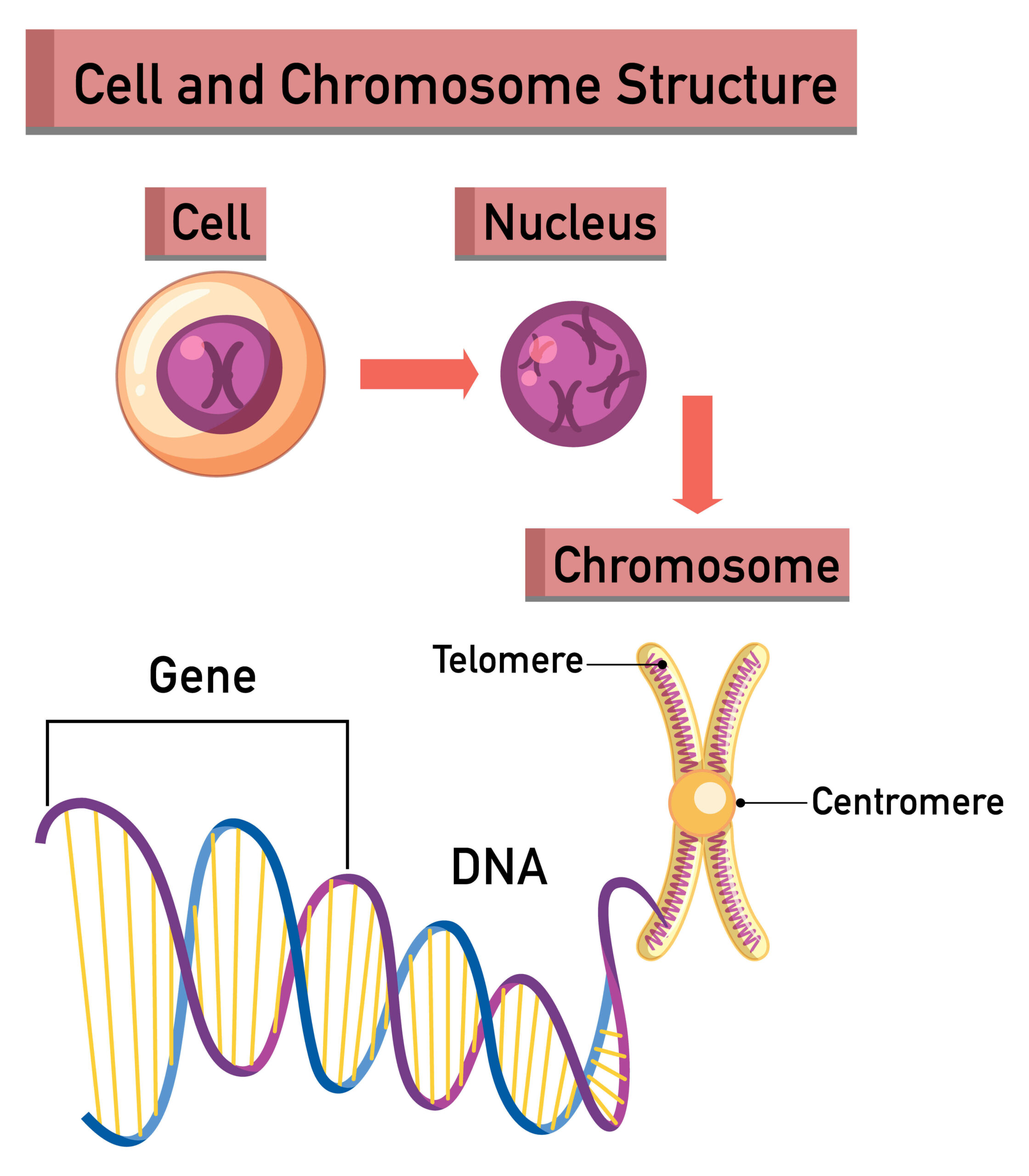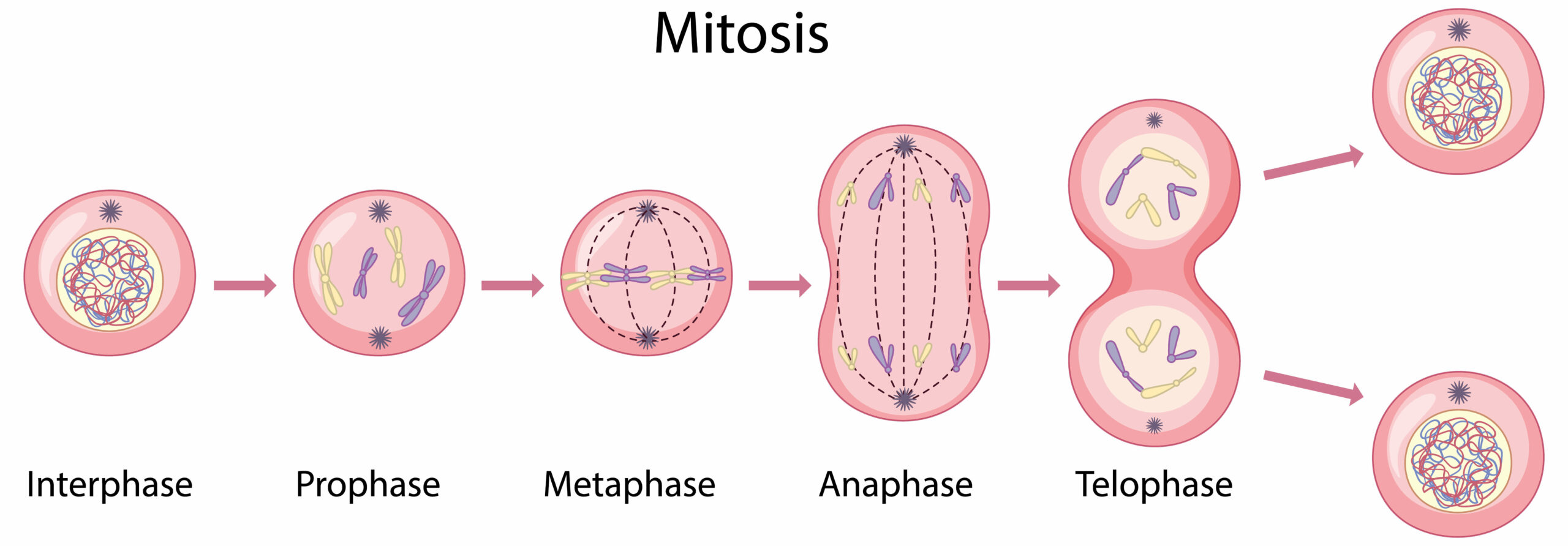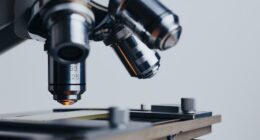Diploid cells have two sets of chromosomes, while haploid cells have one set. Diploids are typical in somatic cells, haploids in gametes.
Have you ever wondered about the difference between diploid and haploid cells? These terms refer to the ploidy of cells, which is the number of sets of chromosomes they contain. Understanding the cellular difference between diploid and haploid cells is essential for understanding genetic material and the processes of sexual reproduction.
Key Takeaways:
- Diploid cells contain two sets of chromosomes, one from each parent, while haploid cells have only one set.
- Meiosis is the process responsible for forming haploid cells through reduction in chromosome number, while diploid cells are formed through mitosis, resulting in the production of identical daughter cells.
- Haploid cells, such as gametes, are used in sexual reproduction, while diploid cells are found in most cells of higher organisms.
- Ploidy plays a crucial role in genetics and inheritance, as genes are located on chromosomes and inherited from parents.
- Understanding the difference between diploid and haploid cells is essential in studying genetic traits and heredity.
The Number of Chromosome Sets

The most obvious difference between haploid and diploid cells lies in the number of chromosome sets. Haploid cells contain only one set of chromosomes, denoted as (n), while diploid cells possess two sets of chromosomes, known as (2n). This distinction in ploidy is fundamental to understanding cellular differences and genetic diversity.
Polyploidy, on the other hand, involves an alteration in the number of chromosome sets. While haploid cells have one set and diploid cells have two sets of chromosomes, polyploidy can result in cells with more than two sets. Polyploid organisms can range from having three sets to even millions of sets of chromosomes, leading to increased genetic material and potential variations.
Caption: Haploid cells have one set of chromosomes (n), while diploid cells have two sets of chromosomes (2n).
| Cell Type | Number of Chromosome Sets | Ploidy |
|---|---|---|
| Haploid Cells | One set (n) | Monoploid |
| Diploid Cells | Two sets (2n) | Diploid |
| Polyploid Cells | More than two sets (3n, 4n, 5n, etc.) | Polyploid |
Reproductive Processes
In the world of cellular reproduction, two key processes come into play: meiosis and mitosis. These processes are responsible for the formation of haploid and diploid cells, which play essential roles in the reproduction of organisms.
The Process of Meiosis
Meiosis is a specialized form of cell division that occurs in the reproductive organs of organisms engaged in sexual reproduction. This process results in the formation and production of haploid cells.
During meiosis, the diploid cell—the one that contains two sets of chromosomes—undergoes two rounds of division, resulting in four daughter cells. However, compared to the original diploid cell, these daughter cells are haploid, meaning they only contain one set of chromosomes.
The reduction in chromosome number occurs because, during meiosis, homologous pairs of chromosomes undergo pairing and exchange of genetic material, leading to genetic diversity. This exchange of genetic material, known as recombination, ensures that each haploid cell formed is genetically unique.
Through meiosis, haploid cells are produced and serve a crucial role in sexual reproduction, as they combine with another haploid cell during fertilization to form a diploid zygote, which then develops into a new individual.
The Process of Mitosis
In contrast to meiosis, mitosis is a form of cell division that occurs in all cells of an organism, excluding sex cells. The primary goal of mitosis is to produce identical daughter cells, thereby enabling growth, repair, and maintenance of the organism’s body.
Diploid cells undergo mitosis, which involves a single round of division, resulting in two diploid daughter cells. Unlike meiosis, mitosis does not involve a reduction in chromosome number or the exchange of genetic material.
The process of mitosis can be divided into several distinct phases: prophase, metaphase, anaphase, and telophase. These phases ensure the accurate separation and distribution of genetic material to each daughter cell.
In summary, while both meiosis and mitosis are crucial in cellular reproduction, they have distinct characteristics and roles. Meiosis produces haploid cells, contributing to genetic diversity and essential for sexual reproduction. On the other hand, mitosis produces identical diploid cells, supporting growth and maintenance in most cells of higher organisms.
| Process | Number of Division | Number of Daughter Cells | Chromosome Number | Main Function |
|---|---|---|---|---|
| Meiosis | Two | Four haploid cells | Half the number of chromosomes as the original cell | Formation of gametes for sexual reproduction |
| Mitosis | One | Two diploid cells | Same number of chromosomes as the original cell | Growth, repair, and maintenance of the organism’s body |
Examples of Haploid and Diploid Cells
Haploid cells and diploid cells are two different types of cells found in organisms. Haploid cells contain one set of chromosomes, while diploid cells contain two sets of chromosomes. Let’s explore some examples of each.
Haploid Cells
Haploid cells are typically involved in sexual reproduction and are responsible for carrying genetic information from one parent to the other. The main examples of haploid cells are gametes, which are reproductive cells.
- Male gametes, also known as sperm cells, are haploid cells that are produced in the testes of male organisms. These cells carry genetic material and are responsible for fertilizing the female gametes.
- Female gametes, also known as egg cells or ova, are haploid cells that are produced in the ovaries of female organisms. These cells carry genetic material and are capable of being fertilized by male gametes to initiate the development of an embryo.
Here is an image of a sperm cell, a haploid gamete:
Diploid Cells
Diploid cells, on the other hand, contain two sets of chromosomes and are found in most cells of higher organisms. These cells have both homologous pairs of chromosomes, one from each parent, which allow for genetic diversity and variation.
Examples of diploid cells include:
- Blood cells: Red blood cells, white blood cells, and platelets are all diploid cells found in the circulatory system.
- Skin cells: The cells that make up our skin, called skin cells or epithelial cells, are diploid cells that provide protection and form a barrier between our body and the external environment.
- Muscle cells: Muscle cells, or muscle fibers, are diploid cells that make up our muscles and enable movement.
Here is an image of a red blood cell, a diploid somatic cell:
Understanding the difference between haploid and diploid cells is essential in studying genetics and reproductive processes. The examples provided demonstrate the variety of cells and their role in the overall functioning of an organism.
Characteristics of Haploid Cells
Haploid cells are a unique type of cells that contain only one set of chromosomes. This is in contrast to diploid cells, which have two sets of chromosomes. The haploid condition is achieved through the process of meiosis, which involves the reduction of chromosome number.
One of the key characteristics of haploid cells is their genetic diversity. During meiosis, homologous chromosomes pair up and exchange genetic material through a process called recombination. This results in the shuffling and mixing of genetic information, leading to the creation of genetically diverse haploid cells.
Genetic diversity is essential for the survival and evolution of species. It provides the raw material for natural selection and allows for adaptation to changing environments. Haploid cells contribute to genetic diversity by introducing new combinations of alleles, which are alternative forms of genes. This diversity ensures that offspring are not exact replicas of their parents, but rather have unique genetic profiles.
Another important characteristic of haploid cells is their role in fertilization. When haploid cells from male and female individuals fuse during fertilization, a diploid cell is formed. This diploid cell then undergoes cell division through mitosis to produce a new individual. The fusion of haploid cells during fertilization ensures that the offspring inherit genetic material from both parents, resulting in genetic variation.
The genetic diversity provided by haploid cells and the process of fertilization contribute to the survival and evolution of species. By enabling the creation of unique individuals with a combination of genetic traits, haploid cells play a critical role in shaping the genetic landscape of populations.
| Characteristics | Haploid Cells |
|---|---|
| Chromosome Sets | One set of chromosomes |
| Genetic Diversity | High due to meiosis and genetic recombination |
| Role in Fertilization | Fuse with haploid cells of the opposite sex to form a diploid cell |
Characteristics of Diploid Cells
Diploid cells are a fundamental component of higher organisms, playing a critical role in various biological processes. Unlike haploid cells that contain only one set of chromosomes, diploid cells possess two sets of chromosomes, denoted as 2n.
The diploid state is achieved through the fusion of two haploid cells, combining the genetic material from both parents. This fusion enables diploid cells to carry a complete set of genetic information necessary for the proper functioning of an organism.
Most cells in higher organisms, with the exception of sex cells, are diploid. These somatic cells perform vital functions, such as maintaining tissues, carrying out metabolic processes, and enabling growth and development. Examples of diploid cells include blood cells, skin cells, and muscle cells.
Diploid cells undergo the process of mitosis, which ensures the accurate distribution of genetic material to daughter cells during cell division. This process enables the production of identical copies of diploid cells, allowing for the growth, repair, and regeneration of tissues and organs.
Characteristics of Diploid Cells:
- Contain two sets of chromosomes (2n)
- Formed by the fusion of two haploid cells
- Found in most cells of higher organisms, excluding sex cells
- Undergo mitosis for cell division
- Examples: blood cells, skin cells, muscle cells
| Diploid Cells | Haploid Cells |
|---|---|
| Contain two sets of chromosomes (2n) | Contain only one set of chromosomes (n) |
| Formed by the fusion of two haploid cells | Formed through the process of meiosis |
| Found in most cells of higher organisms, excluding sex cells | Mainly used in sexual reproduction |
| Undergo mitosis for cell division | Undergo meiosis for cell division |
Importance of Chromosome Sets and Ploidy
When it comes to genetics and inheritance, understanding the role of chromosome sets and ploidy is crucial. Chromosomes are the carriers of genes, which contain the genetic information inherited from parents. By studying the ploidy of cells and the functions of chromosomes, scientists gain valuable insights into genetic traits and heredity.
Genes, located on chromosomes, determine specific characteristics and traits in organisms. They play a vital role in the development, growth, and functioning of living organisms. Inheritance of genes occurs through the transmission of chromosomes from parents to offspring. Therefore, comprehending the structure, behavior, and organization of chromosomes is essential in unraveling the mysteries of genetics.
Chromosome sets, such as diploid and haploid cells, are fundamental to genetic processes. Diploid cells, with two sets of chromosomes, are ubiquitous in most cells of higher organisms. They undergo mitosis, resulting in the production of identical daughter cells. On the other hand, haploid cells have one set of chromosomes and are mainly used in sexual reproduction. They are formed through the process of meiosis, which involves a reduction in the number of chromosomes, providing genetic diversity among offspring.
By studying the ploidy of cells, scientists can gain insights into the inheritance patterns and variations among different organisms. Ploidy levels are essential in determining the genetic diversity within a population and the potential for adaptation to changing environments. Moreover, the study of ploidy plays a significant role in plant breeding, as it allows for the manipulation and hybridization of different chromosome sets to develop new varieties with desirable traits.
Comparison of Diploid and Haploid Cells
| Characteristic | Diploid Cells | Haploid Cells |
|---|---|---|
| Number of Chromosome Sets | Two sets (2n) | One set (n) |
| Role in Reproduction | Involved in both sexual and asexual reproduction | Mainly used in sexual reproduction |
| Genetic Diversity | Lower genetic diversity due to identical chromosome sets | Higher genetic diversity due to the process of meiosis |
| Examples | Blood cells, skin cells, muscle cells | Gametes (sperm and eggs) |
Understanding the importance of chromosome sets and ploidy is crucial in various fields, including medical genetics, evolutionary biology, and plant breeding. By delving deeper into the intricate mechanisms of chromosomes and their role in inheritance, scientists can unlock the secrets of genetic traits and improve our understanding of the natural world.
Gregor Mendel and the Chromosomal Theory of Inheritance
Gregor Mendel, known as the father of genetics, made significant contributions to our understanding of inheritance. Through his experiments with pea plants, he established the chromosomal theory of inheritance, which revolutionized the field of genetics.
Mendel’s groundbreaking work revealed that traits are passed down from parents to offspring through genes located on chromosomes. He discovered that these genes come in different versions called alleles, which interact with each other to determine the expression of traits.
By meticulously studying and documenting patterns of inheritance in pea plants, Mendel uncovered the fundamental principles that govern the passing of traits from one generation to the next. His experiments demonstrated that some traits are dominant, while others are recessive, influencing the phenotypic characteristics of the offspring.
Mendel’s work paved the way for the modern understanding of genetics and inheritance. His findings provided a solid foundation for further research in the field, which ultimately led to the unraveling of the structure and function of DNA, the molecule that carries genetic information.
The image above depicts Gregor Mendel, emphasizing his significant contributions to the field of genetics and the discovery of the chromosomal theory of inheritance.
Alternating Life Cycles and Chromosome Sets
Some organisms, like fungi, have alternating life cycles where both haploid and diploid forms occur naturally. This alternating life cycle is essential for genetic recombination and variation. Let’s explore how haploid and diploid cells come into play during the reproductive processes of meiosis and mitosis.
The Role of Meiosis
During meiosis, haploid cells are produced. Meiosis is a specialized type of cell division that leads to the formation of gametes, such as sperm and eggs. In this process, the diploid cells undergo two rounds of division, resulting in four haploid cells. These haploid cells contain half the number of chromosomes compared to diploid cells. Meiosis plays a crucial role in sexual reproduction and enables the combination of genetic material from two parents, leading to genetic diversity.
The Role of Mitosis

Diploid cells are formed through the process of mitosis, which is a type of cell division that produces two identical daughter cells. In mitosis, the diploid cells replicate their genetic material and divide into two diploid cells. This process is responsible for the growth, development, and maintenance of tissues and organs in multi-cellular organisms.
By transitioning between haploid and diploid forms through meiosis and mitosis, organisms with alternating life cycles achieve genetic recombination and variation, allowing them to adapt to changing environments and enhance their survival strategies.
Maintaining and Altering Chromosome Sets
In the processes of mitosis and meiosis, chromosome doubling and reduction play crucial roles in maintaining the integrity of chromosome sets. These processes ensure the proper distribution of genetic material and contribute to the stability and functionality of cells. However, errors can occur during these processes, leading to alterations in chromosome number and potentially resulting in conditions such as aneuploidy.
Mitosis and Chromosome Doubling
Mitosis is a cellular process that occurs in most cells of the body and is responsible for an accurate replication and division of chromosomes. During mitosis, the chromosomes are duplicated, resulting in a full set of homologous chromosomes in each daughter cell. This duplication or “doubling” ensures that each new cell receives the same complement of genetic material as the parent cell.
Meiosis and Chromosome Reduction
Meiosis, on the other hand, is a specialized process that occurs in cells involved in sexual reproduction. It involves two rounds of division, resulting in the production of haploid cells (cells with half the number of chromosomes compared to the parent cell). This reduction in chromosome number is critical for the formation of gametes (sperm and egg cells) and maintaining the correct ploidy level in the offspring.
Errors and Aneuploidy
While mitosis and meiosis are highly regulated processes, errors can occur that disrupt the normal distribution of chromosomes. These errors are often referred to as nondisjunction, where chromosomes fail to separate properly during cell division.
One consequence of nondisjunction is aneuploidy, which is characterized by an abnormal number of chromosomes in the cells. Aneuploidy can result in various genetic disorders and developmental abnormalities. Examples of aneuploidy include monosomy (loss of a chromosome) and trisomy (gain of an extra chromosome).
Another type of alteration in chromosome sets is polyploidy, where cells have more than two sets of chromosomes. Polyploidy can occur naturally or through artificial manipulation, and it is observed in certain plants and animals. There have been cases where polyploid organisms exhibit different traits and capabilities compared to their diploid counterparts.
Summary
Mitosis and meiosis are essential processes for maintaining and altering chromosome sets. While chromosome doubling is crucial in mitosis, ensuring accurate distribution of genetic material to daughter cells, meiosis involves chromosome reduction, resulting in haploid cells for sexual reproduction. Errors in these processes can lead to alterations in chromosome number and conditions like aneuploidy. Understanding the mechanisms and implications of maintaining and altering chromosome sets provides valuable insights into genetics and heredity.
Abnormalities in Chromosome Sets
Abnormalities in chromosome sets can result in genetic mutations and various conditions. These abnormalities can lead to diseases and disorders such as Down syndrome or cri du chat syndrome. Let’s take a closer look at some specific abnormalities:
Deletion
A deletion occurs when a portion of a chromosome is missing or deleted. This can lead to the loss of important genetic material and disrupt the normal functioning of genes. Deletions can have varying impacts depending on the size and location of the deleted segment.
Repetition
Repetitions, also known as duplications, happen when a segment of a chromosome is repeated. This can result in an excess amount of genetic material, which may lead to abnormal gene function or an imbalance in gene expression.
Inversion
Inversions occur when a segment of a chromosome is reversed in its orientation. This can disrupt the normal pairing and alignment of chromosomes during meiosis. Inversions can affect gene expression and potentially lead to chromosomal abnormalities in offspring.
Translocation
Translocations involve the rearrangement of genetic material between two non-homologous chromosomes. This can result in the fusion of genes from different chromosomes or the exchange of genetic material between chromosomes. Translocations can have significant effects on gene function and can be associated with certain cancers.
Fragile Sites
Fragile sites are specific regions of chromosomes that are susceptible to breakage, particularly under certain conditions or genetic factors. Fragile site abnormalities can lead to chromosomal instability and may be associated with certain genetic disorders.
Understanding these abnormalities in chromosome sets is crucial in diagnosing and studying genetic conditions. Now, let’s take a closer look at some specific examples of disorders that result from these abnormalities.
Conclusion
Understanding the cellular difference between diploid and haploid cells is crucial in comprehending the fundamentals of genetics and the intricate processes that regulate cellular function. The key distinction lies in the number of chromosome sets present within each type of cell. Diploid cells possess two sets of chromosomes, one inherited from each parent, while haploid cells only have a single set.
The genetic material contained within these cells is of utmost importance, as it determines the characteristics and traits inherited by organisms. Diploid cells, which are prevalent in higher organisms, undergo mitosis, creating genetically identical daughter cells. In contrast, haploid cells are primarily involved in sexual reproduction, forming through the process of meiosis, which reduces the number of chromosomes.
The significance of ploidy becomes evident in the study of genetics and inheritance. Chromosomes house the genes that carry the hereditary information from parents to offspring. By understanding the ploidy of cells and the role of chromosomes, researchers can gain insights into the transmission of genetic traits and the complexities of heredity.
FAQ
What is the difference between diploid and haploid cells?
Diploid cells have two sets of chromosomes, one from each parent, while haploid cells have only one set of chromosomes.
How many chromosome sets are there in diploid cells?
Diploid cells have two sets of chromosomes.
How many chromosome sets are there in haploid cells?
Haploid cells have only one set of chromosomes.
What is polyploidy?
Polyploidy occurs when there are more than two sets of chromosomes in a cell, ranging from three to even millions of sets.
How are haploid cells formed?
Haploid cells are formed through the process of meiosis, which involves a reduction in the number of chromosomes.
How are diploid cells formed?
Diploid cells are formed through the process of mitosis, which results in the production of identical daughter cells.
What are examples of haploid cells?
Examples of haploid cells include gametes, which are male or female germ cells involved in sexual reproduction.
What are examples of diploid cells?
Examples of diploid cells include blood cells, skin cells, and muscle cells, which are known as somatic cells.
What is the function of haploid cells in sexual reproduction?
Haploid cells are mainly used in sexual reproduction as they fuse during fertilization to form a diploid cell.
What is the function of diploid cells in higher organisms?
Diploid cells are found in most cells of higher organisms, besides sex cells, and play a role in various physiological functions.
Why are chromosome sets and ploidy important in genetics and inheritance?
Chromosome sets and ploidy are important because genes, which are located on chromosomes, are inherited from parents and play a role in genetic traits and heredity.
Who is Gregor Mendel and what did he contribute to the understanding of inheritance?
Gregor Mendel, known as the father of genetics, established the chromosomal theory of inheritance by studying trait inheritance in pea plants and discovering the role of genes located on chromosomes.
How do alternating life cycles in organisms like fungi involve both haploid and diploid forms?
During meiosis, haploid cells are produced, and during mitosis, diploid cells are formed in the alternating life cycles of organisms like fungi, allowing for genetic recombination and variation.
How are chromosome sets maintained in mitosis and meiosis?
In mitosis and meiosis, the processes of chromosome doubling and reduction ensure the maintenance of chromosome sets.
What can happen when errors occur in chromosome doubling or reduction?
Errors in chromosome doubling or reduction can lead to changes in chromosome number and result in conditions like aneuploidy.
What are examples of abnormalities in chromosome sets?
Examples of abnormalities in chromosome sets include deletions, repetitions, inversions, translocations, and fragile sites, which can lead to genetic mutations and various conditions.
Why is it important to understand the difference between diploid and haploid cells?
Understanding the difference between diploid and haploid cells is crucial in understanding genetics and cellular processes, as it plays a role in genetic variation, inheritance, and the study of genetic traits and heredity.
Source Links
- https://www.diffen.com/difference/Diploid_vs_Haploid
- https://byjus.com/biology/difference-between-haploid-and-diploid/
- https://www.albert.io/blog/diploid-vs-haploid-similarities-differences/
Image Credits
Featured Image By – kjpargeter on Freepik
Image 1 By – brgfx on Freepik
Image 2 By – brgfx on Freepik








